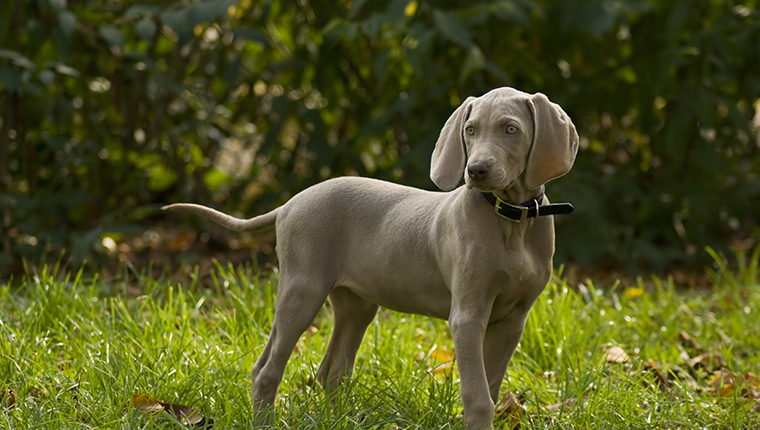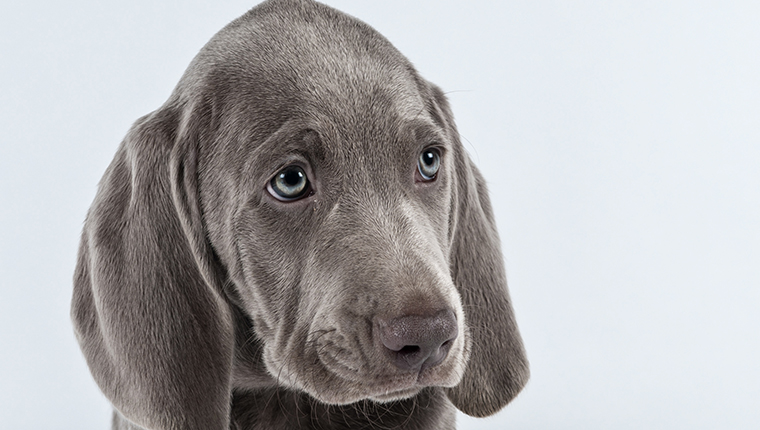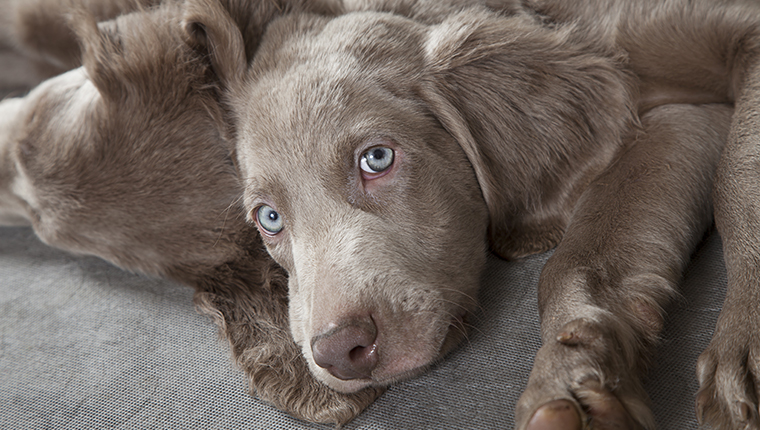Weimaraner puppies sure are adorable, and if you looked at the pictures above, you already know that much!
If you grew up watching Sesame Street–or if you’re just a fan of dog art–chances are you’re familiar with William Wegman and his adorable Weimaraner dogs. These regal-looking silver canines give off an air of confidence and calm. Also, they’re fairly patient, considering all of the clothes they let their photographer-owner put on them.
You may enjoy Weimaraners so much that you’re considering adopting a Weimaraner puppy of your own! But before you run out to a rescue or shelter to get a shiny-coated pup, there are a lot of things to learn about Weimaraner puppies.
These muscular, adorable dogs have a short but extremely detailed history, and they require some special care. Here are a few facts you should know about Weimaraner puppies if you plan to make one a part of your family.
1. They Were Bred By German Nobility
(Picture Credit: dohlongma/HL Mak/Moment/Getty Images)
Unlike some dog breeds that have been around for hundreds and hundreds of years, the Weimaraner is a relatively new breed.
Originally called Weimar Pointers, these dogs were bred by noblemen as hunting dogs. With their muscular tone and overall amicable personality, the Weimaraner made the perfect companion for nobility who hunted for sport.
The dogs hunted large game. They were bred to be quick, have incredible scent-tracking abilities, and to be fearless. As the German nobles tinkered with breeding, the Weimaraner got their signature shiny, gray coat.
They earned their name from the Weimar Republic, and allegedly Grand Duke Karl August of Sachsen-Weimar created the breed entirely by himself, although there is no concrete evidence supporting the notion.
2. They Were For Nobles Only

(Picture Credit: digihelion/iStock/Getty Images Plus)
The noblemen of Weimar were very fond of the breed they created. In order to keep the breed up to standards, the people of the Weimar Court refused to let just anyone get their hands on a puppy.
In 1897, they created a club for the breed, and only hand-chosen members were allowed to get their very own Weimaraner puppies. Fortunately, that is no longer the case, and there are even rescues dedicated to Weimaraners!
Weimaraners made their way to the States in the 1920s, and by 1942, the American Kennel Club officially recognized the breed.
3. They Have Stripes And Blue Eyes As Puppies

(Picture Credit: Guy Cali/Corbis/Getty Images Plus)
While Weimaraners are typically known for their solid gray or blue coats, they don’t start out that way.
Like a reverse Dalmatian–who are born spotless–Weimaraner puppies earn their solid coats over time. Weimaraner puppies have darker tiger stripes that fade a few days after birth.
Weimaraner puppies also have piercing blue eyes when they’re born. This doesn’t mean your Weimaraner puppy’s eyes will stay blue, though. When the pups are born, their eyes don’t produce enough melanin to give them any distinctive color.
There isn’t an exact deadline on those baby blues, but Weimaraner puppies typically gain enough melanin for brown, amber, or blue-grayish eyes between the ages of two and six months.
4. They Can Have Long Hair, Too

(Picture Credit: alkir/iStock/Getty Images Plus)
Traditionally, Weimaraners have short, sleek coats in a blue or gray color. However, a select few fall into a longer hair breed, and–although rare–long-haired Weimaraners exist.
These long-haired Weimaraners were bred for hunting, much like their short-haired counterparts.
The fluffier Weimaraners were meant to hunt waterfowl, so they were selectively bred for longer hair to keep them warm in cold winter waters.
5. They Are Incredibly Smart–And Sometimes Mischievous

(Picture Credit: ek65/iStock/Getty Images Plus)
Experienced Weimaraner owners will tell you that their dogs are smarter than your average pup. In fact, they are often referred to as “the dog with a human brain.”
This smart breed needs a lot of mental exercise to go along with their physical training. They were bred to be super hunters, which means they have a sharp eye, keen sense of smell, and strong muscles on top of being mentally agile.
If you don’t stimulate your Weimaraner puppy enough, they will quickly become bored and get into mischievous situations to alleviate said boredom.
6. They Need A Substantial Amount Of Exercise

(Picture Credit: ek65/iStock/Getty Images Plus)
Weimaraners were bred to be agile, strong hunters. They’re also whip-smart, which means Weimaraner puppies are ready to play, solve puzzles, and hunt for hidden treats all day.
This makes Weimaraners excellent family puppies, as they love to play, wrestle, and search for secrets in the backyards with kids. They are good with single pup parents, too, as long as the parent knows how to keep their Weimaraner occupied.
For those without a backyard, there are lots of fun games to play during walks. There are also a lot of active games that can be played indoors or outdoors to keep your Weimaraner happy.
A sedentary lifestyle will not cut it for this breed. Unfortunately, if you aren’t home often or feel strapped for time or space, a Weimaraner puppy may not be for you.
That is not to say you can’t have a Weimaraner if you live in a compact or urban setting. You’ll just need to be conscious about getting your Weimaraner puppy the exercise and outdoor space they need.
7. They Crave Companionship

(Picture Credit: alkir/iStock/Getty Images Plus)
The good news is even though your Weimaraner may be a little rambunctious, at the end of the day, they truly want to be your best bud. Weimaraners are notoriously affectionate. They love to snuggle and see what you’re up to.
Some people have even claimed that their Weimaraner pup has no qualms popping in the tub with them. Many owners even compare them to velcro–they always stick.
While having a cuddly dog is amazing, that also means that they can be prone to separation anxiety. Fortunately, there are easy ways to curb this type of anxiety.
Their buddy-buddy persona also means they are not the type of dogs who can be left out in a yard all day or at home for long stretches of time. If you’re thinking about getting a Weimaraner puppy, make sure you have the time and energy to commit to this snuggly breed.
Do you have a Weimaraner puppy? What challenges did you face while raising them? Do you have any advice for first-time Weimaraner parents? Let us know in the comments below!